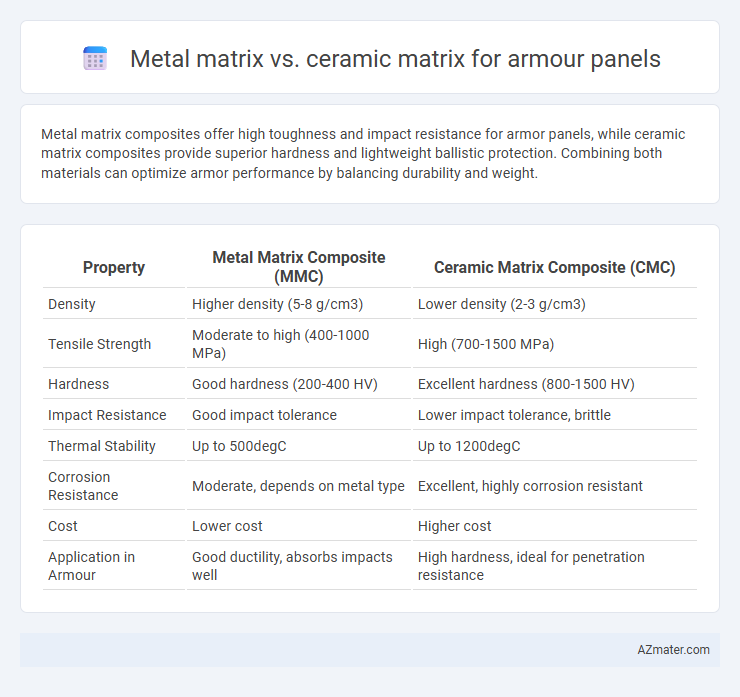Metal matrix composites offer high toughness and impact resistance for armor panels, while ceramic matrix composites provide superior hardness and lightweight ballistic protection. Combining both materials can optimize armor performance by balancing durability and weight.
Table of Comparison
| Property | Metal Matrix Composite (MMC) | Ceramic Matrix Composite (CMC) |
|---|---|---|
| Density | Higher density (5-8 g/cm3) | Lower density (2-3 g/cm3) |
| Tensile Strength | Moderate to high (400-1000 MPa) | High (700-1500 MPa) |
| Hardness | Good hardness (200-400 HV) | Excellent hardness (800-1500 HV) |
| Impact Resistance | Good impact tolerance | Lower impact tolerance, brittle |
| Thermal Stability | Up to 500degC | Up to 1200degC |
| Corrosion Resistance | Moderate, depends on metal type | Excellent, highly corrosion resistant |
| Cost | Lower cost | Higher cost |
| Application in Armour | Good ductility, absorbs impacts well | High hardness, ideal for penetration resistance |
Introduction to Armour Panel Materials
Metal matrix composites exhibit superior toughness and impact resistance, making them ideal for armor panels that require high durability under ballistic stress. Ceramic matrix composites offer enhanced hardness and lightweight protection, excelling in dissipating high-velocity projectile energy while minimizing panel weight. Choosing between metal and ceramic matrices depends on the desired balance of strength, weight, and energy absorption in armor panel design.
Overview of Metal Matrix Composites (MMC)
Metal Matrix Composites (MMC) for armor panels combine high-strength metal alloys with reinforced fibers or particles, significantly enhancing mechanical properties such as toughness, strength, and impact resistance. These composites offer superior thermal conductivity and damage tolerance compared to Ceramic Matrix Composites (CMC), making them particularly suited for dynamic combat environments where multi-hit capability is crucial. MMC armor panels provide improved weight efficiency and structural integrity, balancing protection and mobility in advanced defense applications.
Overview of Ceramic Matrix Composites (CMC)
Ceramic Matrix Composites (CMCs) are engineered materials combining ceramic fibers within a ceramic matrix, offering superior thermal stability, lightweight properties, and exceptional resistance to high-velocity impacts, making them ideal for advanced armor panels. Compared to Metal Matrix Composites (MMCs), CMCs provide enhanced hardness and oxidation resistance, which improves durability in extreme environments. Their ability to maintain structural integrity at elevated temperatures makes CMCs crucial for lightweight, high-performance defensive applications.
Key Properties: Metal Matrix vs Ceramic Matrix
Metal matrix composites for armor panels offer superior toughness, impact resistance, and ductility compared to ceramic matrix composites, which exhibit higher hardness and better ability to withstand high temperatures. Ceramic matrix armor panels provide excellent ballistic protection through superior energy absorption and reduced weight but are more brittle and prone to cracking under high stress. Metal matrix composites balance strength and flexibility, making them ideal for applications requiring resistance to both penetration and deformation.
Ballistic Performance Comparison
Metal matrix composites (MMCs) offer high toughness and ductility, allowing armor panels to absorb and dissipate kinetic energy effectively against ballistic threats. Ceramic matrix composites (CMCs) exhibit superior hardness and high compressive strength, enabling enhanced penetration resistance and fragmentation control when impacted by armor-piercing rounds. Comparing ballistic performance, MMC armor panels typically provide better multi-hit capability and structural integrity, while CMCs excel in stopping high-velocity projectiles with reduced weight.
Weight and Mobility Considerations
Metal matrix armor panels generally offer higher density and weight compared to ceramic matrix composites, impacting overall mobility in field operations. Ceramic matrix materials provide superior weight reduction, enhancing soldier agility and endurance by easing the load without sacrificing ballistic protection. Optimizing armor design through advanced ceramic composites can significantly improve mobility while maintaining effective defense against high-velocity threats.
Durability and Environmental Resistance
Metal matrix composites in armor panels offer superior toughness and impact resistance, maintaining structural integrity under high-stress conditions. Ceramic matrix composites provide outstanding hardness and exceptional resistance to high temperatures and corrosion, enhancing durability in harsh environmental conditions. Combining metal and ceramic matrices can optimize armor panels by balancing impact absorption with environmental resilience.
Manufacturing and Cost Implications
Metal matrix composites for armor panels offer easier manufacturability through established casting and forging techniques, enabling scalable production and lower overall fabrication costs. Ceramic matrix composites provide superior hardness and thermal resistance but require complex sintering and hot pressing processes, increasing manufacturing time and expense significantly. Cost implications favor metal matrices for mass production due to reduced energy consumption and simpler tooling, whereas ceramic matrices remain costly and challenging for high-volume applications.
Applications in Military and Civil Sectors
Metal matrix composites (MMCs) in armor panels offer superior toughness and impact resistance, making them ideal for military vehicles and personal protective equipment that require high durability against ballistic threats. Ceramic matrix composites (CMCs) provide exceptional hardness and thermal stability, suitable for lightweight armor in aerospace applications and civilian security barriers where weight reduction and heat resistance are critical. Both materials are increasingly deployed in military armor systems and civil infrastructure due to their complementary strengths in balancing protection, weight, and operational performance.
Future Trends in Armour Panel Materials
Metal matrix composites (MMCs) offer superior toughness and impact resistance, making them ideal for ballistic armor applications, while ceramic matrix composites (CMCs) provide exceptional hardness and thermal stability crucial for multi-hit protection. Future trends indicate a hybrid approach combining MMCs and CMCs to optimize weight, durability, and energy absorption under extreme conditions. Advances in nanotechnology and additive manufacturing are expected to enhance the microstructural properties and scalability of these composite materials, driving innovation in next-generation armor panels.

Infographic: Metal matrix vs Ceramic matrix for Armour panel
 azmater.com
azmater.com